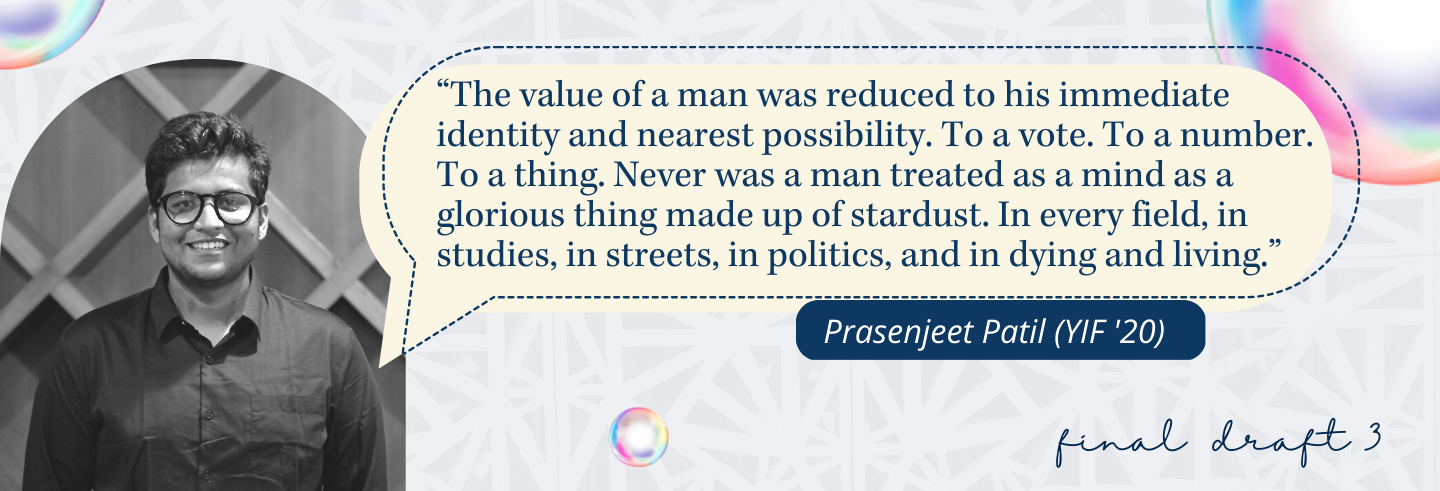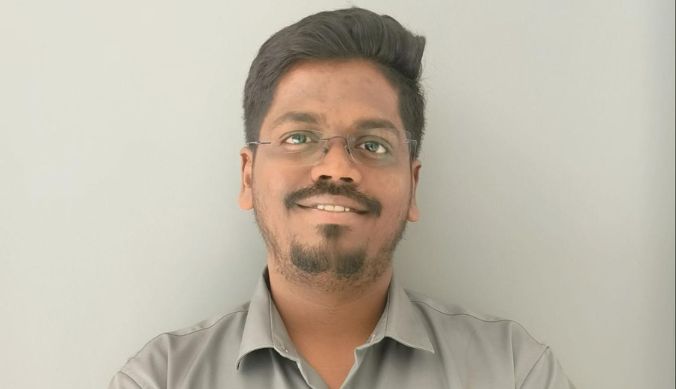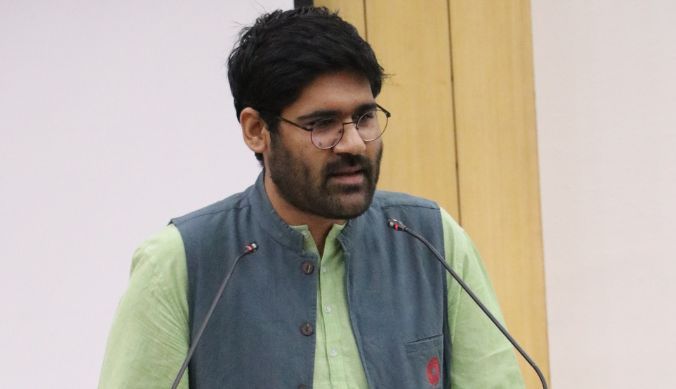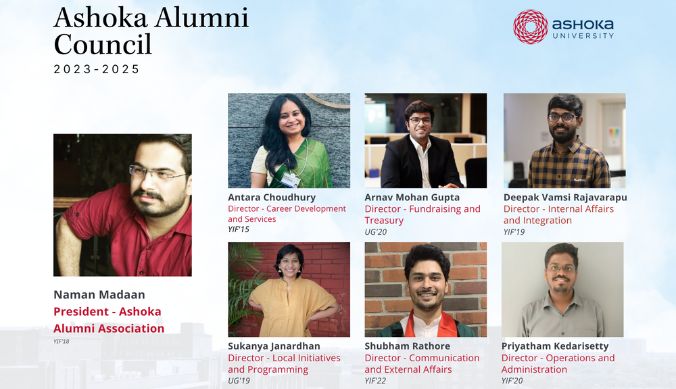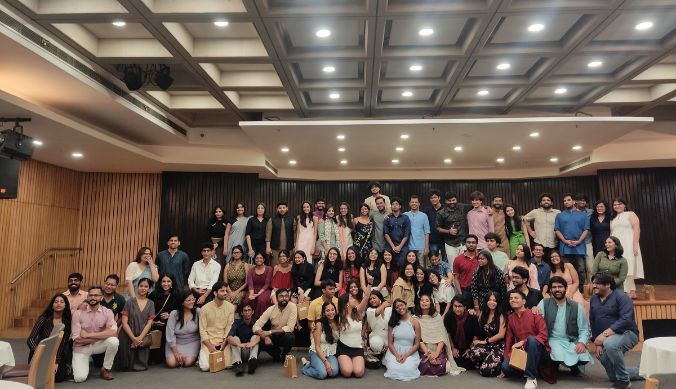‘Caste in Higher Education: Examining and Redefining Affirmative Action’
Featuring Prasenjeet Patil’s creative piece that developed as an original project over his term at the Young India Fellowship

Prasenjeet Ramesh Patil
9 March, 2023 | 6m readAbstract:
Prasenjeet describes the existing roadblocks in effectively implementing caste-based affirmative action policies (particularly for SC and ST students). He provides socially and historically grounded arguments for why affirmative action is necessary, but also draws attention to the possible limitations of existing policies and provides a few suggestions for how they can be improved.
Article:
Introduction
On 17 January 2016, Rohith Vemula, a young PhD scholar at the University of Hyderabad, was martyred. In his suicide note, he expressed his desire to be a writer of science. Rohith, unfortunately, could not fulfil this dream of his. He wrote in his suicide note, “My birth is my fatal accident. I can never recover from my childhood loneliness. The unappreciated child from my past.” One can only imagine the grief in these lines and the experiences that led him to take this drastic step. He writes further, “I am not hurt at this moment. I am not sad. I am just empty. Unconcerned about myself. That’s pathetic. And that’s why I am doing this.”1
Rohith was part of the Ambedkar Students Association (ASA). They, under the banner of ASA, organised a protest condemning the hanging of Yakub Menon. The event was met with an intense backlash from the Akhil Bharatiya Vidyarthi Parishad (ABVP), a radical Hindu right-wing student political organisation. The hostility between ABVP and ASA grew, and ABVP enjoyed the support of the administration. It eventually led to a discriminatory and arbitrary expulsion of Rohith, along with four of his colleagues from the hostel. They slept outside the hostel premises as a symbol of continued protest for 15 days.
Further, Rohith had not been receiving his PhD stipend of Rs 25,000 from the university for the past seven months. These events affected Rohith emotionally and mentally, as is evident from his letter to the university’s vice chancellor. In the letter, he demanded a rope and sodium azide for all Dalit students. This persistent caste-based systemic discrimination was compounded for Rohith and eventually forced him to take his own life.
Rohith Vemula’s suicide opened Pandora’s box of casteism that still exists in higher education. This event raised questions about the extent of inclusive practices and policies by universities and institutions towards students holding marginal identities. The report, submitted by teachers of the Hyderabad Central University (HCU), claimed that a total of nine Dalit students had committed suicide between the years 2001 and 2013.
In 2008, 12 students (11 identifying as Scheduled Castes and one identifying as Scheduled Tribe) were expelled from IIT Delhi with the rationale that they were academically weak. This decision was abysmal because it was made within six months of them joining the institution.
One can agree that affirmative action in the form of reservation in higher education institutions has contributed to a significant increase in the enrolment rate of students identifying as Scheduled Caste (SC) and Scheduled Tribe (ST). In the long run, reservation has played an influential role in economic upliftment, increased representation in the workforce, and social prestige as an outcome of occupation for the SC and ST population. However, there still exists an institutional breakdown once these students enter higher education institutions. They are often subjected to structural and institutional discrimination.
This essay attempts to describe these issues at length and highlights the longstanding repercussions of this systemic exclusion cascading to experiences beyond higher education. Although reservations for students identifying as Other Backward Classes (OBC) exist, they have been excluded from the scope of this essay. The rationale for this is that SC and ST students are most marginalised and oppressed based on access to social, economic, and cultural resources. Hence, this essay majorly focuses on them. However, the implications of the arguments made in the essay could be extended to OBC communities as well.
This essay consists of three sections. The first section explores the need for reservation in higher education and offers perspectives on its contribution towards positive social change. The second section dwells on the experience of the SC and ST students post their academic exposure through the lens of job readiness and security. Lastly, alternate affirmative actions are discussed that can be adopted at a structural and institutional level to make education accessible and attainable to all.
Status of Higher Education for SC, ST Students
The upper castes account for about a little more than one-third of the total population, yet they constitute more than two-thirds of those with professional and higher education degrees. According to the National Sample Survey Organisation (2011–12), the under-represented castes—SCs, STs, and OBCs, represented 71.5 per cent of the total population and hold poor representation in the educational and professional circuit. Hindu upper castes have roughly double the total number of graduates among all other castes and communities put together (Deshpande 2439). It is improbable that the figures have significantly improved through the years, especially regarding graduates in the technical domain like engineering and medicine.
Reservation policies account for about 15 per cent of reserved seats for SC students, 7.5 per cent for ST students, while it is 27 per cent for OBC students. The cut-off margin for SC, and ST students is less than that of the general category. Moreover, it has been observed that SC and ST students score relatively lower than the established general category cut-off. A study conducted at a medical college in Pune showed that merely one-sixth of SC and ST category students scored enough to be admitted as general-entry students, while for OBC, it was five-sixths (Weisskopf 4340). We can conclude from this study that these students would probably not have entered these institutions had the reservation policy not existed.
The lower score of students in these entrance examinations could be attributed to multiple factors. One could be the lower quality of educational exposure at higher secondary level and, possibly before that, backtracking to early childhood education. Thus, students competing in these entrance examinations are already at a disadvantage. Second, the weak financial status of students from these identities restricts them from availing facilities like tuition, which in general are expensive and play a pivotal role in moulding students to perform better in the competitive examinations for prestigious higher institutions.
Higher education has been accessible, attainable, and accomplishable for SC and ST students because of affirmative action. The number of enrolments has increased over the years. Nevertheless, many seats reserved for SC and ST students at prestigious institutions like IITs, AIIMS and JNU remain unavailable to them. Moreover, the opportunity to access higher education has contributed to improving three spheres—social capital, knowledge and skills, and socio-economic status. The university experience allows them to not only establish a network with peers whom they can reach out to professionally and personally but also opportunities post-higher education have contributed to an improvement in their economic status.
The idea of affirmative action should be welcomed by students belonging to upper-caste groups as a measure to make university spaces more inclusive. As Thomas Weisskopf rightly points out, such integration promotes greater diversity, better political representation, better workforce representation, and upliftment of the under-represented strata of society. Reservation within higher education has provided opportunities to establish social prestige and build financial assets, thus improving economic status (Deshpande 2441). Over the years, the number of students aspiring to attain higher education has increased, thus making these institutions highly ‘selective’. These circumstances have created a system of nationwide competitive examinations that determine ‘merit’ based on the parameter of a mere exam score.
Merit, in a literal sense, refers to the ‘quality of being particularly good or worthy’. In the context of higher education, merit determines the competence and aptitude of a candidate through selective examination or what may be appropriately termed an elimination examination. The number of seats and cut-off are predetermined. The examination, using merit as a basis, serves as a tool to create a dichotomy of being ‘accepted and rejected’ for students. Further, it legitimises the exclusion of students by saying ‘No’ based on performance. For merit to be a legitimate basis to select the ‘worthy’ and ‘best’ amongst the pool of students, one would have to assume that all the students are equipped equally with respect to economic, social, and cultural resources. However, this is not the situation.
Satish Deshpande rightly points out that examinations are based on the premise that merit contains an element of ‘resource discrimination’. Resource discrimination is born out of the discrimination of inadequate and inequitable resources for access and success in higher education concerning SC and ST students (2441). Resource discrimination further is a function of inequitable backgrounds, cultures, economic facilities, and the cultural differences in spoken language that are ultimately reduced to being ‘dialects’. These ‘dialects’ are systematically excluded from the ambit of the dominant language(s) spoken by privileged populations (Ilaiah 2308).
Marc Galanter argues that three broad kinds of resources are necessary to produce results in a competitive examination—a. Economic resources, b. Social and cultural resources, and c. Intrinsic motivation and hard work (Galanter 10). A common argument made by the upper-caste population is that merit solely holds the reason for their majority representation at higher education institutions. Assuming that the argument is valid, then it would mean that amongst the three resources mentioned by Galanter, only intrinsic motivation is missing amongst people belonging to SCs and STs. While there is no detailed research on the above conclusion, the idea that millions of SCs and STs lack intrinsic motivation comes across as an improbable assumption and hence, could be termed as an unsound argument.
The notion of merit propagates unequal opportunities for students, especially for those identifying as SCs and STs. The idea of merit needs to be re-evaluated thoroughly, and robust policy interventions are needed that could substantially replace the resource-discriminatory merit system and the connotations associated with it through interventions that are inclusive of marginalised people. Reservation serves a part of this purpose by somewhere ensuring the representation of SC and ST at higher education institutions. However, the current framework of merit simultaneously also serves as a tool for discrimination, and subsequent marginalisation and alienation of students belonging to SC and ST communities once they enter higher educational institutions. A testimony to this lies in the experiences of SC and ST students at higher education institutions.
Experience of SC, ST Students— Institutions and Beyond
Anoop Kumar, an Ambedkarite activist and founder of the Nalanda Academy in Wardha, argues that most SC students opt for traditional courses rather than professional courses because of a lack of guidance. There has been an evident systemic gap in providing support to students once they enter these institutions. It has been observed that the performance of students belonging to the SC and ST categories has been inferior to their peers from the general category.
There are multiple reasons for the above, as rightly pointed out by Anoop Kumar. First, SC and ST students entering these institutions already come from weak economic backgrounds. As an outcome, more often than not, students drop out midway. The state has provided scholarship schemes for students belonging to SC and ST backgrounds, but that has not been very impactful in retaining students. It could be attributed to multiple factors— insufficiency of scholarship amounts to manage all expenses, inconsistency in the transfer of scholarship amounts to students’ bank accounts and lack of awareness about available scholarship schemes for SC and ST students. Second, the poor state of primary education already leaves them with less proficiency in grade-level learning outcomes.
On top of that, the medium of instruction and evaluation is English, which acts as a significant barrier for students hailing from vernacular-medium schools. There are no adequate linguistic support systems to help students learn the language. These factors result in lower academic outcomes for SC and ST students compared to the general category students. Third, the explicit and implicit discrimination faced by these students at the hands of fellow students from upper-caste communities. A single paramount experience that almost all the SC and ST students have claimed to have had is that of being labelled as non-meritorious based on their academic performance or their lesser linguistic proficiency compared to their general category student fraternity or because they used their reservation to enter the institutions (Kumar, ‘“Merit’ Is Constructed via Coaching Centres”).
These experiences leave a profound psychological impact on the SC and ST students: self-doubt. Loss of self-worth. Loss of self-esteem. Cultural alienation. Low confidence. Negative self-image. Negative community image. Inferiority complex. The list is long. Anoop Kumar elaborates further on the mental health of SC and ST category students, claiming that these factors are also contributing to high dropout rates. One cannot ignore the possibility of self-harm that may arise from a chronic feeling of failure.
The negative self and community image may result in them rejecting this identity and conforming to the majoritarian hegemonic culture. Diane de Anda, in her “Bicultural Socialising Factors Affecting the Minority Experience”, calls this process ‘Bicultural Socialisation’. She explains that an individual belonging to the minority subordinate culture interacts with the majority culture through any of three ways— translators, mediators, and models. The first instinct for a subordinate group while interacting with the majority homogeneous culture is to blend with their culture. The rationale is simple— it paves the way for a path of least resistance for oneself. Diane de Anda argues that this is done by developing the behavioural trait that conforms with the majority homogeneous culture (de Anda 104). An example of the above can be seen in certain students, who, instead of leveraging education to uplift their community further, have become ignorant and even repulsed by their caste identity.
Job readiness and post-education transition have also been a struggle for SC and ST students. They find it challenging to secure a job through campus placements. The factors perpetuating this could be traced to their college education discourse—academic and social. A study was conducted on a sample of students from Milind College of Arts—a college in Aurangabad dedicated to students belonging to the SC category. It was found that while the students after graduating on average earned more than their fathers, the students transitioned from a ‘traditionally poor background’ to what he termed as a ‘disadvantaged educated class’. None of the graduates managed to secure class I or II (administrative, as opposed to clerical or menial) jobs despite SC reservations for these jobs (Weisskopf 4345).
Another survey conducted amongst 143 IT professionals in Bangalore revealed that of the majority of the participants, 88 per cent were Hindus, 5 per cent were Christian, and 2 per cent identified themselves as Muslims. Brahmins constituted almost 50 per cent of the sample. Among 143 participants, only one identified with Scheduled Caste. The class composition was mainly upper class, upper middle class, and middle class. The majority of the professionals hailed from five metro cities or Tier 2 cities like Mysore and Pune. Professionals belonging to rural backgrounds and Tier 3 cities came from financially well-off and middle-class families (Upadhya 1864).
The lack of representation of SC and ST students is evident across domains and hierarchies at the workplace. Although the IT industry cannot be blamed for the under-representation of these students within the industry, one could argue that they can still be blamed for not meaningfully intending to diversify their workforce. Their role is to select candidates who will be an asset to the business. This process of ‘selecting candidates from the pool of applicants happens through multiple screening rounds, reinforcing the systemic exclusion that SC and ST students face. First, the process includes initial shortlisting that demands a minimum score of 70 or 75 per cent, thus discouraging the aspirations of many SC and ST students due to their underperformance at higher education institutions. Second, it requires them to go through a technical round that tests aptitude and comprehension skills. Third, there is an HR interview, wherein the objective is to convey a message to the company that the candidate is an excellent cultural fit and will be an asset to the business. Communication plays a vital role in acing this round, the medium of which happens to be English—proficiency of which is inferior in SC and ST students compared to the general category students.
Affirmative actions have ensured that students enrol in higher educational institutions, with stars in their eyes and the dreams of their parents in their hearts. However, the systemic exclusion at higher education institutions and failure to support them during their educational journey have contributed to turning those stars into dust and dreams into broken pieces of glass. This systemic and institutional failure calls for a revamp of affirmative action policies, support systems, and structures.
Redesigning Affirmative Actions
There is a need for the affirmative action policy to undergo modification and be deployed effectively, not only on a structural level but on an institutional level as well. The first issue that needs to be resolved while defining a measure is whether we should focus on attainment or enrolment (Basant and Sen 63). While it has been established that reservation has enabled SC and ST students to enrol in higher educational institutions, educational attainment still faces a huge gap that needs to be addressed. Systemic-level interventions would be required to create a space that stands on the pillars of inclusivity and equitable outcomes for students.
The affirmative action of the reservation has catered mainly to the ‘creamy layer’ of the SC and ST population at a systemic-policy level. Only certain castes in some states have been able to utilise it for their upliftment. For example, the Mahars in Maharashtra and the Chamars in Uttar Pradesh. There needs to be a further elaborate enquiry into the broad spectrum of castes to ensure that those at the lower end of SCs, STs, and OBCs benefit from it. Anand Teltumbde argues that reservation has caused more division amongst the beneficiary castes. He proposes that caste could be segregated into two parts—those who have availed of reservation and those who are yet to benefit from the reservation. The castes who have availed of the reservation before, would not be able to avail it for a second time. He insists that this would benefit the other sub-castes who usually are unable to benefit from the reservation.
Further, this is not against the Constitutional provision of reservation and the right against discrimination enshrined in Article 15 and might promote further equality within castes (Teltumbde 17). However, community upliftment takes generations to occur. While availing of reservation once may arguably improve the educational and economic status of a family, the question remains whether the subsequent generation will be equipped with resources and social capital to compete with the privileged castes.
Pradipta Chaudhury, in her essay, “The ‘Creamy Layer’: Political Economy of Reservations”, argues that the politics of caste identity founded on reservations help to push the economic problems facing the poor away from the centre stage. Moreover, it also prevents the poor belonging to high, middle, and low castes from uniting along class lines (Chaudhury 1990). The system of economic conditions as a criterion for providing reservations is ineffective. How would one determine what parameters of economic conditions should be considered to determine reservation? What mechanisms can we leverage to ensure that people are transparent while disclosing their economic conditions to avail of reservation?
A few proposals are the focus of this section. First, the unfulfilled seats at prestigious institutions like IITs, AIIMs, and JNU. An article titled “Caste Discrimination in IIT Delhi: A Report” notes that almost half of the SC/ST seats in IITs remain unfulfilled. Twenty-five per cent of the candidates from those seats that have been filled drop out. The figures are alarming and give an image of an immense loss to the community (Kumar, “Caste Discrimination in IIT Delhi: A Report”). Indeed, fewer applicants are not the problem here. Perhaps a lack of support at these institutions and fewer candidates who fit the required criteria stands as a hindrance. Although IITs have introduced systems like ‘preparatory year’ for SC and ST students to train them for the rigorous engineering tenure, yet the situation has not significantly improved.
There is a need to establish support systems throughout the engineering tenure. It not only equips them to cope with rigorous academics but also equips them with better preparedness for future prospects. The remedial classes for English are not conducted effectively and efficiently. Borrowing from Anoop Kumar’s experience, faculty take up these classes as an act of formality. One One-hour class per week! It is expected that four to five hours of classes will bring students at par with the students who have received their education in English-medium schools. Further, there is a stigma attached to these classes. These classes are for SC/ST students. These classes are for the ‘weak’ students. No one wants to be associated with such remarks, which propagate a sense of humiliation amongst SC and ST students. There is a need to make these remedial classes effective and efficient across government institutions and private-aided and unaided institutions, where many SC/ST students enrol. Perhaps, sensitisation sessions for faculty, social conversations in the institutional space, and robust curriculum design could prove a good start. It would not only normalise the conversation around remedial classes but could also address the stigma attached to them. Moreover, deliberate research focusing on why students do not participate in the deployed targeted structures such as remedial classes is needed. It would enable the design of meaningful and effective interventions.
Second, the SC/ST cell has to be made more effective and efficient in its redressal mechanisms on caste-based discrimination in educational spaces. There needs to be accountability within the institutional administration to ensure the same. Accountability also has to lie with the government to ensure that the cells are rightly placed at institutions and are functioning.
Third, primary and secondary education, especially in low-income, under-resourced schools, needs to be strengthened. A majority of SC and ST students end up enrolling in these schools. This is a complex problem, and at a systemic level, multiple factors contribute to it—poor infrastructure, fewer teachers, inadequate teacher training, low attendance, poor nutrition, and weak early childhood education. This will require deliberate policy-level interventions and effective institutional implementation.
At the micro-level, ‘community centres’ could be established to provide educational, emotional, and psychological support to SC and ST students. One could imagine it as an environment to foster knowledge and the life skills (vocational training) necessary for various professional spheres. This would equip students with a better understanding and mastery over grade-level knowledge pieces and a positive self-image and identity. Further, community centres could also be leveraged to address the need to make students aware of career opportunities, provide them with aligned resources, and connect them with people who would help them navigate their educational journey successfully. The onus also lies with the SC and ST community professionals. They have availed the benefits of reservation to lend financial, emotional, and psychological support to current university students and enable them to make successful careers. There has to be a collective consciousness amongst SC and ST professionals to actively contribute towards the upliftment and betterment of their contemporaries. We owe this to Dr Babasaheb Ambedkar.
Educational institutions are sacred places where dreams are nurtured. Students have a bright future for themselves in mind coupled with high hopes placed by parents. It is a matter of despair that these dreams are crushed and hopes shattered once students enter these institutions due to the burden of holding an oppressed caste identity. What value does education hold if institutions and their people discriminate against the less privileged? How effective is the notion of ‘merit’ when the opportunities and resources themselves are discriminatory? How many suicides does one have to witness to question the systems and institutions? How many Rohiths do we need to lose to realise as a community that something needs to change? ‘Community’ does not only refer to the Dalits and Adivasis. It also addresses the people holding a position of power and privilege.
Rohith writes, “The value of a man was reduced to his immediate identity and nearest possibility. To a vote. To a number. To a thing. Never was a man treated as a mind as a glorious thing made up of stardust. In every field, in studies, in streets, in politics, and in dying and living.” These words, rather than reflections, demand that we evaluate our position in the dynamics of power and privilege operating in society. There is a dire need to acknowledge one’s privilege, especially in places like educational institutions. There is a need to deploy systems of meaningful interventions and severe repercussions on discrimination against marginalised students by the government to make the educational system inclusive for them.
There is a need for social conversations within the upper castes and lower castes around questions of power and privilege. This would only prove effective if it is supplemented by conscious efforts by upper castes to acknowledge their position of power and privilege and actively work towards dismantling it. Lastly, people from lower castes, who now occupy the position of social privilege and capital, should reach out to their less privileged community. It is necessary to have a sense of community and contribute towards the upliftment and empowerment of their comrades. The struggle persists!
About the Author:
I currently work as an educator at Byju’s, building interactive and engaging learning products. My interest in writing developed during my undergraduate days, when I started writing short stories. Apart from writing, I was also passionate about education. With the belief that education can lead to creating a just and equitable society, I joined Teach for India (TFI) as a teaching fellow. Being a teacher to a bunch of enthusiastic eighth graders, I learnt the importance of the power of a well-reasoned, lucid, and engaging argument, which further cemented my interest in writing.
Following TFI, an interdisciplinary academic engagement at Young India Fellowship helped me connect my on-ground experiences to theory within an academic environment. As a part of the critical writing course, I began to explore the intersection of education and social identity through the dynamics of caste, power, privilege, and oppression in educational spaces—which ultimately contributed to this essay. I intend to continue learning and writing about education and society while exploring interventions towards making quality education accessible to all students.
About YIF CW Programme:
The YIF Critical Writing programme is a unique, one-of-a-kind opportunity for Fellows to hone their critical thinking and writing skills under the able supervision of trained experts in the field. The CW programme employs a constantly evolving pedagogy, making learning and knowledge production more collaborative and dialogic. Preceptors at the YIF CW programme teach writing through a range of topics including but not limited to ‘History, Philosophy, and Anthropology of Science’, ‘Politics of Language and Multilingualism’, and ‘Education, Literacy, and Justice’.
About Final Draft:
The Final Draft is the annual journal of the YIF Critical Writing programme. It showcases the range in topic and genre, as well as the strength of writing in the highly diverse YIF student body. These pieces of writing, submitted by Fellows from various classes of the YIF represent only a small fraction of the variety and range of writing done over the years.
About our campaign:
Through our ‘Final Draft 3’ campaign, we hope to give you a glimpse into some of the styles and voices that have evolved, the concerns and ideas that fellows have explored and the seriousness of their engagement with writing as drafts in motion; searching for meaning and connection, which makes this more of a pedagogic exercise book.
(The piece was first published in the Final Draft, A Journal of the YIF Critical Writing Programme.)
Study at Ashoka







